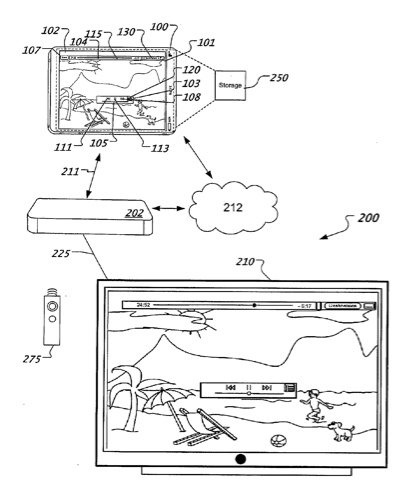Apple has been granted a patent (number 20120050012) for adaptive media content scrubbing on a remote device — in other words, iMovie for iOS devices. The patent also hints at upcoming features of the software.
Systems and techniques are disclosed for controlling, from a mobile device, media content stored on the mobile device to a media client for presentation on a display device. Data can be provided from the mobile device to the media client for identifying the location of the media content and a playback time. Based on the data, the media client can obtain a portion of the media content associated with the playback time. Also, playback of the media content on the display device can be controlled by a user of the mobile device. The inventors are Thomas Matthieu Alsina, Bob Bradley, Alan Cannistraro, Scott Forstall, Amandeep Jawa, Nicholas V. King, Lucas Newman, Daniel Trent Preston, Jai Chulani and Jeffrey Robbin.
Here’s Apple’s background and summary of the invention: “As media devices and online providers of media content have become more prevalent, the choices of media types and selection of particular media items have grown considerably and will continue to do so. Manufacturers of media devices strive to present this vast array of available media choices to a viewer in a meaningful way. Media content can be presented on a mobile device such as cell phone, PDA, a tablet computer and the like.
“Media content can also be presented on a TV or a home theater system using a media device such as a digital media receiver or digital media adapter. Such a media device can connect to a network to download digital media files and play them on a home theater system or TV.
“This disclosure describes systems and techniques for controlling, from a mobile device, media content stored on the mobile device to a media client for presentation on a display device coupled to, or integrated with, the media client such as a television. The media content can be stored on the mobile device and presented to a user on the mobile device. A separate media device, such as media client, coupled with the display device can be identified by the mobile device. The media client can be linked to the mobile device over a communications link, such as over a local area network (LAN) or over a wireless peer-to-peer communications link.
“The user can switch the destination of the presentation of the media content from the mobile device to the display device coupled to the media client. For example, the user can click on a list of destinations on the mobile device and select a destination associated with the media client which switches the presentation of the media content from the mobile device to the display device. The media content can be provided from the mobile device to the media client for presentation on the display device. Also, playback of the media content on the display device can be controlled from the mobile device.
“When the destination of the media content is changed from the mobile device to the media client, the mobile device can stop decoding (and decrypting if the media content is encrypted) the media content. A portion of the media content, starting from the location where mobile device left off when the destination was received, can be provided to the media client in encoded (and encrypted) form. The media client can decode (and decrypt) the media content and present the media content on the display device.
“To provide the media content to the media client, the mobile device can transmit data (e.g., a URL) to the media client that includes an address (e.g., an Internet Protocol (IP) address) of the mobile device, an asset identifier (‘ID’) of the media content stored on the mobile device, and a playtime where the media device should begin presenting the media content. Based on the data, the media client can prepare and send a request (e.g., an HTTP request) to the mobile device for a portion of the presentation (e.g. packets of information). Upon receiving the request, the mobile device transmits the requested portion of the presentation. The media client can continue to transmit requests and buffer media content so that the media content can be seamlessly presented on the display device.
“The mobile device from which the media content is sent can also control the presentation of the media content by the media client. For example, a user can scrub the presentation of the media content using a control provided by the mobile device. To do so, the mobile device can monitor the status of the presentation of the media content by the media client so that when a scrubbing request is received, the mobile device can scrub from the correct location. While the user is scrubbing the media content at the mobile device, the mobile device can decode (and decrypt) frames (e.g. key frames) of the media content associated with the scrubbing for display on the mobile device.
“Once a new location in the media content is determined based on the scrubbing input, a new data can be transmitted to the media client with information for the media client to request media content associated with the new location. In some examples, as the scrubbing input is received, commands can be transmitted to the media client to obtain and display frames from the mobile device associated with the scrubbing and present those frames as the scrubbing input is received (e.g. real-time scrubbing).”


